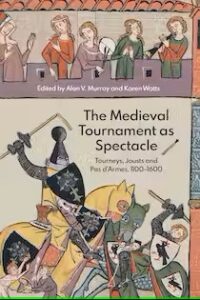Alan V. Murray and Karen Watts (eds.)
The Medieval Tournament as Spectacle: Tourneys, Jousts and Pas d’Armes, 1100-1600
(Boydell and Brewer, 2023), 263pp. $38.95 (pb)

The Medieval Tournament as Spectacle contains a series of articles examining the cultural impact and importance of medieval knightly sport combat in all its various forms. Although the articles span the high Middle Ages to the early modern period, the majority focus on the fifteenth and early sixteenth centuries. This is simply due to the available source materials, which proliferate in the fifteenth century. The book is organized roughly across chronological lines, beginning with an examination of the earliest mentions of tourneys and going through the sixteenth-century exemplars of extravagance and pageantry. Equipment is studied in detail too, with well-placed images, which provides the modern reader with proper visuals to aid in the understanding of the historical terminology upon which many of the articles rely. There are also deep dives into the juxtaposition of real tourneys and the fictional accounts of great feats of arms and concomitant courtly love.
Alan Murray first surveys the earliest detailed accounts of German tournaments, shedding new light on the development of both the spectacles themselves as well as the literature focused on them. He notes that there was already a courtly literature by the thirteenth century which imagined fanciful and majestic tourneys. This stands in contrast to the historically attested tourneys, which garnered little more than a single sentence in some records. Perhaps the most interesting aspect of historical tourneys lies in their sheer diversity. Some were ad hoc arrangements formed by bored knights, while others garnered the attention of nearly all of Europe. The larger ones had elaborate pageantry, including knights in highly decorated armor, with bundles of painted lances in tow. Unlike later tourneys, jousters before the fifteenth century often made the rules of their games on the spot, although the basic framework of the challenge was omnipresent across the continent. Murray notes that the greatest incentive for participation lay in the prestige of victory. There was certainly a possibility that one could take his opponent’s armor and ransom his captive, but sometimes knights forswore enrichment to participate in a tournament for glory and honor. This went hand-in-hand with the development of heraldry which, Murray notes, was specifically designed to identify a particular combatant on the field. The tourneys were, in the words of Josephus, “bloodless wars,” from which knights could gain glory with (slightly) less risk than a true battle.
Such aggrandizements of private honor had more far-reaching consequences in Medieval politics, however. James Beswick examines the Smithfield tournament of 1390, noting that the English tournaments had, from their outset, a decidedly political impact. They were used by the English kings as a kind of grand ceremonial that publicized their royal authority. Richard’s 1390 tournament had allowed him to quell a civil war and win powerful men over to his side. What had begun inauspiciously in the 1380s was, by the mid-1390s, turned around so completely that the king’s private retinue had increased nearly ten times its original size. The pageantry demonstrated the wealth of the realm and the generosity of the king, while his feats of arms or sponsorships of other warriors demonstrated his courage and eye for talent.
The equipment of these sport-combats was notedly different from their battlefield counterparts. Ralph Moffat uses an array of illustrations and artworks to make viscerally clear the unique designs and artistic flourish with which they were decorated. Of scholarly interest, both in terms of pure academia and experimental archaeology, are the numerous rosters of jousting equipment Moffat examines over a century of tournaments. While in themselves essentially receipts or inventories, simple linguistic differentiation between armor and “armor for the joust” shows the recognition of sporting equipment in opposition to equipment of war. By the fifteenth century, this had encouraged a culture of armor collection among many knights, who would discuss and argue over various accoutrement and their effectiveness in the tournament.
Similar specialization was found in the design of saddles. Marina Viallon details the development, first of the warrior’s saddle from the eleventh century through the fifteenth, then of the coterminous development of the jousting saddle from the fourteenth century onward. As tournaments became more specialized and organized sporting events, so too did their equipment become more specialized to their respective combats. The saddles of the joust were made at first with special padding in front of the thigs, though this would eventually evolve into higher pommels with hardened leather or even metal plates to guard the rider from slipping lance heads. Jousting cantles would slowly encroach upon the upper hips, holding the rider firmly in his saddle during the impact. Although such changes also found their way onto the battlefield, the jousting pommel and cantle were much taller than their combat counterparts. Both would utilize a standing position, having long stirrups and a high seat to allow the knight to impart as much force as possible into his weapon. The development of the jousting saddle from the war saddle was a natural outgrowth of the popularity of the tournament with the wealthy warriors of medieval Europe.
The compendium does an excellent job bringing in the casual reader to the intricacies of the study of tourneys, while also broadening the knowledge of those more invested in such research. Most of the essays begin with a historiographical survey that is fair and nuanced, showing both the giants upon whom their studies are built and the holes still remaining in the field. This is then followed up by detailed research, none of which relies on academic jargon or unexplained terms. The pictures are well chosen and aid the chapters on military equipment particularly. Readers come away from the book with an imagination’s worth of images and stories, both historical and literary. On top of everything else, it really is a fun read.
Joe Morrel
University of Dallas
